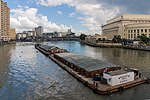Pier 4 station
Pier 4 station is a proposed Manila Light Rail Transit (LRT) station situated on Line 2 which will serve as the new western terminus of the line. It is part of the Line 2 West Extension project, which will extend the current line by up to 3.02 kilometers (1.88 mi). The extension line will begin at Recto station and will end at the Manila North Harbor in Tondo. The west extension project calls for the construction of three additional elevated stations, two on Recto Avenue and one on Mel Lopez Boulevard near Pier 4 of the Manila North Harbor. It was approved by the National Economic and Development Authority on May 19, 2015.The station would be the third and last for trains headed west from Recto and the fifteenth or last for trains headed from Antipolo. The station will rise on Mel Lopez Boulevard and it will be located 50 meters north of Zaragoza Street, right in front of the Manila North Port Passenger Terminal Complex in Pier 4. Currently, the station is in the planning stages.
Excerpt from the Wikipedia article Pier 4 station (License: CC BY-SA 3.0, Authors).Pier 4 station
Mel Lopez Boulevard, Manila Tondo
Geographical coordinates (GPS) Address Nearby Places Show on map
Geographical coordinates (GPS)
| Latitude | Longitude |
|---|---|
| N 14.603530555556 ° | E 120.96153611111 ° |
Address
Mel Lopez Boulevard (President Ferdinand Marcos Avenue)
Mel Lopez Boulevard
1012 Manila, Tondo
Philippines
Open on Google Maps





